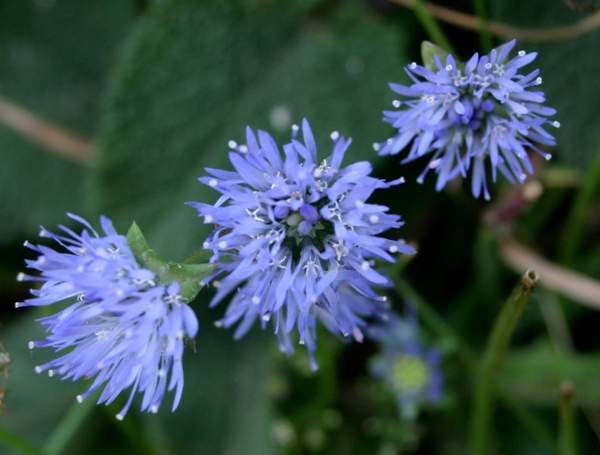Jasione montana
Mountain Echeveria ( Jasione montana), inflorescence with flowers in different stages of development
The mountain - Echeveria ( Jasione montana), also mountain - sand Rapunzel, sand knobs, Mountain Elke or sheep scabious called, is a species of the genus of sand rapunzel ( Jasione ) in the family of the bellflower family ( Campanulaceae ).
To draw attention to this rare species and their endangered habitat, the mountain - Echeveria was chosen in 1990 to the flower of the year. This species is due to heavy nutrient inputs to lean Saumbiotope who are themselves declining, at risk.
- 5.1 Notes and references
Description
Vegetative characteristics
The mountain - Echeveria growing as annuals - wintering or biennial herbaceous plant that plant height of 20 to 60, rarely up to 80 cm reached. The root system runs deep up to 1 meter. There shall be no foothills. The richly branched stems may be prostrate or erect. Complement the surroundings of only in the lower part of stem leaves are oblong to lanceolate and have a wavy - curly edge.
Generative features
The standing on a long inflorescence stem basket- shaped inflorescence reached a diameter of 1.5 to 2.5 centimeters. The twelve or more imbricated bracts are oblong to ovate, taper to a point and usually shorter than the flower. The hermaphrodite flowers are fünfzählig double perianth. The five sepals are shorter than the petals and durable. The five bright blue, rarely white petals are fused at the base Roehrig with five lineal corolla lobes that are just before flowering. There are five stamens with blue, pfriemförmigen stamens present which do not project beyond the crown. The style stands out from the crown and ends in a bilobed scar. The flowering period extends from June to August.
It formed small, standing off at the top with two pores dehiscent, plump and five -edged capsule fruits that are crowned by krallig tough sepals. The almost egg-shaped seeds are small.
Ecology
The mountain - Echeveria is a up to 1 m deep rooted semi- rosette plant (sand plant). The flowers are vormännliche basket flowers, very similar to those of the daisy family. The individual flowers are divided down to the ground. They open from the bottom up. The anthers are fused at the base. They thereby obstruct the way to the nectar and thus serve as a juice ceiling. The pollen is emptied already in the flower bud on the stylus brush. Later, the anthers are spreading, the stylus greatly extended, and the two-lobed stigma unfolds. Pollinators are many Fly, bees (up to 100 species), butterflies and beetles; Self-pollination does not occur. The smallness of the leaves and their harsh hairs are adaptations to temporary drought. The seeds are dispersed by animals and the wind. Pre- Ripening seeds are suitable for the study of embryonic development.
Occurrence
The Echeveria occurs both in mountainous locations as well as in the gray dunes of the North Sea and Baltic Sea coast. It prefers to grow on dry sand - poor grassland or calcium-poor rocky places, but also as a deep-rooted pioneer plant on wastelands. They are found on poor and non-calcareous sandy soils, on dry grasslands, dunes and rock heads.
In Austria, the kind in Vienna is extinct, otherwise scattered to rare in all provinces.
After Ellenberg the mountain Echeveria is a half- light plant, a Trockniszeiger, an acid- pointer, and a Ordnungscharakterart the Felsgrus and rock band societies (Sedo - Scleranthetalia ).
System
Jasione montana was built in 1753 by Carl Linnaeus in Species Plantarum, 2, pp. 928- 929erstveröffentlicht. It is the type species of the genus Jasione.
Jasione montana is very rich in form; it is divided into two subspecies: the widespread clan Jasione montana L. subsp. montana with a higher average and ascending growth and the less common, marine -oriented form '' Jasione montana subsp. Fr litoralis that grows smaller and more decumbent.
Swell
- Albert Dietrich, Friedrich Klotzsch: Flora regni Borussici: flora of the Kingdom of Prussia or picture and description of wild plants in Prussia, Volume 3 Publisher of Ludwig Ochmigke, 1835 Google -book online. . 211: Jasione montana
- The mountain sand Rapunzel ( Jasione montana) - on poor soils adapted by the Ministry for the Environment, Nature Conservation and Transport Baden- Württemberg.
- Mountain - sand bells. In: FloraWeb.de.









